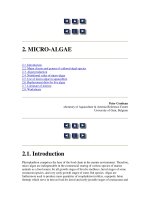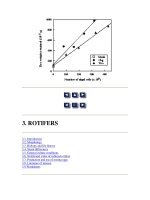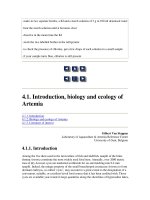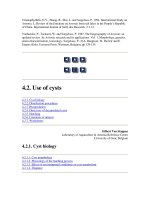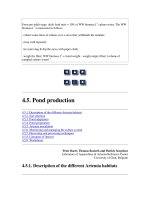Programmatic update Use of Antiretroviral Drugs for Treating Pregnant Women and Preventing HIV Infection in Infants pptx
Bạn đang xem bản rút gọn của tài liệu. Xem và tải ngay bản đầy đủ của tài liệu tại đây (163.2 KB, 7 trang )
HIV/AIDS Programme
Use of AntiretrovirAl DrUgs
for treAting PregnAnt Women
AnD Preventing Hiv infection in infAnts
EXECUTIVE SUMMARY
April 2012
PROGRAMMATIC UPDATE
1
EXECUTIVE SUMMARY
Recent developments suggest that substantial clinical and programmatic advantages can
come from adopting a single, universal regimen both to treat HIV-infected pregnant women
and to prevent mother-to-child transmission of HIV. This streamlining should maximize PMTCT
programme performance through better alignment and linkages with antiretroviral therapy
(ART) programmes at every level of service delivery. One of WHO’s two currently recommended
PMTCT antiretroviral (ARV) programme options, Option B, takes this unified approach.
Now a new, third option (Option B+) proposes further evolution—not only providing the
same triple ARV drugs to all HIV-infected pregnant women beginning in the antenatal clinic
setting but also continuing this therapy for all of these women for life. Important advantages
of Option B+ include: further simplification of regimen and service delivery and harmonization
with ART programmes, protection against mother-to-child transmission in future pregnancies,
a continuing prevention benefit against sexual transmission to serodiscordant partners, and
avoiding stopping and starting of ARV drugs. While these benefits need to be evaluated in
programme settings, and systems and support requirements need careful consideration, this
is an appropriate time for countries to start assessing their situation and experience to make
optimal programmatic choices.
This programmatic update is meant to provide a current perspective for countries on the impor-
tant changes and new considerations arising since publication of WHO’s PMTCT ARV guide-
lines, 2010 version, especially as a number of countries are now preparing to adopt Option
B+. WHO has begun a comprehensive revision of all ARV guidelines, including guidance on
ARVs for pregnant women, planned for release in early 2013.
Prevention of mother-to-child transmission of HIV (PMTCT)
is a dynamic and rapidly changing field. Current World Health
Organization (WHO) PMTCT antiretroviral (ARV) guidelines on
treating pregnant women and preventing infection in infants
(1), issued in 2010, were a major step towards more effica-
cious regimens. The WHO guidelines emphasize the impor-
tance of providing lifelong antiretroviral therapy (ART) to all
HIV-infected pregnant women eligible for such treatment and
recommend two short-term antiretroviral prophylaxis options
(Option A and Option B) for women not eligible under current
criteria, as determined by CD4 count, for treatment for their
own health (Table 1). Recently, a third option, to provide life-
long ART to all HIV-infected pregnant women, regardless of
CD4 cell count, has emerged (Option B+), and a number of
countries are already adopting or considering this approach.
Although many low- and middle-income countries are still
in early stages of implementing the 2010 guidance, new
evidence and recent experience warrant a programmatic
update to reassess preferences between Options A and B
for prophylaxis in HIV-infected pregnant women who do not
need treatment for their own health and to weigh the poten-
tial advantages and considerations of the new Option B+
approach in a public health perspective.
Current WHO guidance on ARV use in HIV-infected
pregnant women
The 2010 WHO PMTCT ARV guidelines are based on the need
to distinguish between treatment and prophylaxis. Consistent
with the 2010 WHO adult ART guidelines (2), they recommend
and prioritize starting all women with CD4 counts ≤350 cells/
mm
3
or WHO Stage 3 or 4 disease (approximately 40–50% of
all HIV-infected pregnant women) on ART for life for their own
health as well as for the prevention of infant HIV infection. For
women with CD4 counts >350 cells/mm
3
, who are not eligible
for treatment according to current criteria, the PMTCT ARV
guidelines recommend starting ARV prophylaxis early in preg-
nancy and, in breastfeeding settings, providing extended ARVs
to either the mother or child during the postpartum risk period.
The two recommended prophylaxis options, A and B, are quite
different programmatically but were judged to be equally effi-
cacious, if implemented appropriately, in reducing the risk of
infant infections for women with CD4 counts >350 cells/
mm
3
. Because of the difference in the prophylaxis options, it is
sometimes not well understood that Options A and B include
both treatment and prophylaxis components, as shown in
Table 1. The overall effectiveness, both for the mother’s health
2
and for preventing new infant infections, of implementing
either of the options depends on providing both ARV treat-
ment to those with low CD4 counts and prophylaxis to those
with higher CD4 counts. Countries were asked to weigh the
benefits and uncertainties of the two approaches, particularly
the operational issues, in order to determine the best approach
for their national programme.
Rationale for this update
In the short time since the 2010 PMTCT ARV guidelines
were developed, the context and expectations for PMTCT
programmes have changed considerably. Major changes
include:
• the ambitious goals for eliminating paediatric HIV infec-
tion of the new Global Plan Towards the Elimination of New
HIV Infections Among Children by 2015 and Keeping Their
Mothers Alive (3), together with substantial progress in the
global scale-up of PMTCT and ART coverage (4);
• new evidence to support ARV treatment as HIV preven-
tion—notably that provision of ART to HIV-infected indi-
viduals with higher CD4 cell counts, who are not eligible
for treatment, significantly reduces sexual transmission to
a serodiscordant (uninfected) partner (5); this evidence
has led to new WHO recommendations on couples
counselling and treatment for serodiscordant couples
regardless of CD4 count (6);
• increasing country experience with operational and
programme implementation challenges with both Option
A and Option B;
• the proposal by some countries to move to the new Option
B+ approach of lifelong ART for PMTCT for all HIV-
infected pregnant women, rather than stopping ARVs for
women not eligible for treatment, as in both Option A and
Option B (7);
• the launch of the Treatment 2.0 Initiative to simplify and
optimize the use of ARVs and standardize the first-line
treatment regimen (8,9);
• reassuring data on the safety of efavirenz in pregnancy
(10); and
• the decreasing cost of ARV drugs (11,12).
In addition, concerns have been raised that WHO’s recommen-
dation of two different options for PMTCT prophylaxis for HIV-
infected women who do not require treatment for their own
health might be confusing and should be reconsidered in light
of newly recognized potential benefits, operational experiences
and the programme requirements of the various options.
Table 1. Three options for PMTCT programmes
Woman receives:
Infant receives:
Treatment
(for CD4 count
≤350 cells/mm
3
)
Prophylaxis
(for CD4 count
>350 cells/mm
3
)
Option A
a
Triple ARVs starting as
soon as diagnosed,
continued for life
Antepartum: AZT starting as
early as 14 weeks gestation
Intrapartum: at onset of
labour, sdNVP and first dose
of AZT/3TC
Postpartum: daily AZT/3TC
through 7 days postpartum
Daily NVP from birth
through 1 week beyond
complete cessation of
breastfeeding; or, if not
breastfeeding or if mother
is on treatment, through
age 4–6 weeks
Option B
a
Same initial ARVs for both
b
: Daily NVP or AZT from
birth through age 4–6
weeks regardless of infant
feeding method
Triple ARVs starting as
soon as diagnosed,
continued for life
Triple ARVs starting as early
as 14 weeks gestation
and continued intrapartum
and through childbirth if
not breastfeeding or until
1week after cessation of all
breastfeeding
Option B+ Same for treatment and prophylaxis
b
: Daily NVP or AZT from
birth through age 4–6
weeks regardless of infant
feeding method
Regardless of CD4 count, triple ARVs starting as soon
as diagnosed,
c
continued for life
Note: “Triple ARVs” refers to the use of one of the recommended 3-drug fully suppressive treatment options.
a
Recommended in WHO 2010 PMTCT guidelines
b
True only for EFV-based first-line ART; NVP-based ART not recommended for prophylaxis (CD4 >350)
c
Formal recommendations for Option B+ have not been made, but presumably ART would start at diagnosis.
3
This programmatic update, while not presenting new guide-
lines, reviews the currently recommended Options A and B,
discusses the rationale for Option B+, and provides an update
from WHO indicating and weighing preferences as much as
possible among the range of options. This update summarizes
key issues that need to be addressed in field settings and in
national programmes. It also highlights evidence gaps that need
to be addressed to build a base for future revision of guidelines.
Key findings
This programmatic update indicates that Options B and
specifically B+ are likely to prove preferable to Option A for
operational, programmatic and strategic reasons. While Option
A has been successfully implemented in a number of high-
burden countries, generally it has been difficult to implement
in many low-resource settings due to the changes in drugs
delivered across the care continuum (antenatal, delivery and
postpartum) and the requirement for timely CD4 testing to
determine which women should initiate ART for their own
health. In contrast, Option B and Option B+ start all HIV-
infected pregnant women on triple ARV regimens without
need for an initial CD4 cell count (although CD4 testing is still
needed in Option B and desirable in Option B+). Thus, Options
B and B+ provide greater assurance that women in need of
treatment receive a fully suppressive triple ARV regimen, to
minimize the risks of infant infection and maximize the benefit
to their own health, and avoid inadvertently receiving a subop-
timal ARV prophylaxis intervention, particularly in settings with
limited access to CD4 testing. Limited access to timely, reli-
able CD4 testing, and thus the inability to identify women in
need of treatment and to initiate treatment, is a major concern
in many resource-constrained settings, especially at the
primary care level, where most women obtain maternal and
child health (MCH) care.
Regimen efficiency and simplification. Another key
advantage of Options B and B+ is greater efficiency, very
much in accord with Treatment 2.0 principles. First, the same
simplified, fixed-dose combination ARV regimen can be used
throughout the PMTCT intervention. Further, it is possible, and
highly desirable, to provide the same regimen both for PMTCT
and as the first-line national ART regimen for non-pregnant
individuals. The ability to use the same regimen for PMTCT
and for first-line ART considerably simplifies drug forecasting,
procurement, supply to facilities, and drug stock monitoring.
The first-line regimen of tenofovir/lamivudine/efavirenz
(TDF/3TC/EFV) is available as a single-pill fixed-dose combi-
nation and has been recommended recently as the optimized
regimen for first-line adult treatment, including for pregnant
women (9). An important advantage of efavirenz in the first-
line regimen is that it can be used in all women, regardless of
CD4 count (unlike nevirapine, which cannot be used in women
with high CD4 counts). Although concerns remain about the
safety of efavirenz in early pregnancy, and enhanced phar-
macovigilance monitoring is needed, review of recent data is
reassuring, and benefits are likely to outweigh risks (10).
Many HIV high-burden countries initially chose Option A
because of limited PMTCT programme support, challenges of
scale-up, lower drug costs, ease of adding on to prior PMTCT
approaches and training, and limited capacity to provide triple
ARVs in MCH settings. However, these factors are changing,
and a number of high-burden countries are considering
moving from Option A to Option B or B+.
Costs. The cost of ARV drugs was a major determinant in
countries’ choice of a PMTCT option. In 2009 the average
ARV drug cost of Option B was three to five times higher than
the cost of Option A (depending on regimen and assuming
the provision of both ART and prophylaxis). However, by the
end of 2011, this differential had diminished to two times
higher. The annual cost of two-pill formulations of TDF/3TC/
EFV has decreased by 30% over the past three years and
is now US$150; the newer TDF/3TC/EFV single-pill fixed-
dose regimen costs approximately US$180 per year (11,12).
Further declines are anticipated. With the differing initial cost
of drugs now less of a factor, analyses of long-term costs,
cost-benefit and cost-effectiveness will be more appropriate
for guiding policy decisions than per person initial cost.
Option B+ advantages. The Option B+ approach of life-
long ART for all HIV-infected pregnant women, regardless
of CD4 count, has important advantages over both Options
A and B (if viral suppression is maintained) but needs to be
evaluated in programme and field settings. These advantages
include:
1. further simplification of PMTCT programme requirements—
no need for CD4 testing to determine ART eligibility (as
required in Option A) or whether ART should be stopped or
continued after the risk of mother-to-child transmission has
ceased (as in Option B) (although CD4 counts or viral load
assays are still desirable for determining baseline immuno-
logical status and monitoring response to treatment);
2. extended protection from mother-to-child transmission in
future pregnancies from conception;
3. a strong and continuing prevention benefit against sexual
transmission in serodiscordant couples and partners;
4. likely benefit to the woman’s health of earlier treatment
and avoiding the risks of stopping and starting triple ARVs,
especially in settings with high fertility; and
5. a simple message to communities that, once ART is started,
it is taken for life.
Challenges and questions. Still, there are important
programmatic, operational and clinical challenges and ques-
tions about Option B+ that need to be addressed, including
service organization and service delivery of ART in MCH and
primary care settings, cost and sustainability, ARV adher-
ence and retention in care, referral mechanisms and transi-
tions from the PMTCT programme to HIV care and treatment
programmes, concerns about HIV drug resistance with long-
term use of ART when initiated in early HIV disease, safety
of increased ARV exposure for the fetus/infant, acceptability
and equity. Thus, countries implementing Option B+ or plan-
ning demonstration projects should be supported to monitor
this approach closely to address these issues and assess the
feasibility, cost-benefit and public health impact of Option B+.
4
WHO advice to countries
In light of global and country commitments to elimination of
new paediatric infections and the changes outlined in this
programmatic update, all countries should examine their own
policy, goals and implementation experiences and assess how
they can better simplify, optimize and integrate their PMTCT
and ART programmes. Countries that are successfully imple-
menting Option A and achieving their targets of decreasing
mother-to-child transmission of HIV and treating mothers
eligible for ART do not need to plan an immediate change to
Option B or B+. Countries that are considering changing their
PMTCT guidelines should anticipate and prepare adequately
for the changes, to assure that clear policy, implementation
strategy, proper messaging, training and an ARV demand fore-
casting and supply system are in place.
Options B and specifically B+ seem to offer important
programmatic and operational advantages and thus could
accelerate progress towards eliminating new paediatric infec-
tions. If Option B+ can be supported, funded, scaled up at the
primary care level and sustained, it will also likely provide the
best protection for the mother’s health, and it offers a prom-
ising new approach to preventing sexual transmission and
new HIV infections in the general population.
There is an urgent need to assess country experiences and
evidence that address the preferences among Options A, B
and B+ outlined here. Evidence on the operational advantages
of providing triple ARVs to all HIV-infected pregnant women
(Options B and B+), on how to best meet the programme
requirements of these approaches, and on the acceptability,
effectiveness and prevention impact of providing lifelong ART
to all HIV-infected pregnant women (Option B+) will help
inform upcoming guidelines revision.
This programmatic update is meant to provide a current
perspective for countries on the important changes and new
considerations arising since the 2010 PMTCT ARV guide-
lines, especially as a number of countries are now preparing to
adopt Option B+. WHO has begun a comprehensive revision
of all ARV guidelines, including guidance on ARVs for preg-
nant women, planned for release in early 2013.
1
Antiretroviral drugs for treating pregnant women and preventing HIV infec-
tions in infants: recommendations for a public health approach, 2010 version.
Geneva, World Health Organization, 2010. />guidelines/en/
2
Antiretroviral therapy for HIV infection in adults and adolescents: recommen-
dations for a public health approach: 2010 revision. Geneva, World Health
Organization, 2010. />3
Joint United Nations Programme on HIV/AIDS (UNAIDS). Countdown to
zero: global plan for the elimination of new HIV infections among children by
2015 and keeping their mothers alive, 2011–2015. Geneva, UNAIDS, 2011.
/>spublication/2011/20110609_JC2137_Global-Plan-Elimination-HIV-Chil-
dren_en.pdf
4
World Health Organization (WHO), Joint United Nations Programme on
HIV/AIDS, and United Nations Children’s Fund. Global HIV/AIDS response:
epidemic update and health sector progress towards universal access: pro-
gress report 2011. Geneva, WHO, 2011. />tions/2011/9789241502986_eng.pdf
5
Cohen MS et al. Prevention of HIV-1 infection with early antiretroviral thera-
py. New England Journal of Medicine, 2011 Aug 11, 365(6):493–505. http://
www.nejm.org/doi/full/10.1056/NEJMoa1105243
6
Guidance on couples HIV testing and counselling and antiretroviral therapy
for treatment and prevention in serodiscordant couples: recommendations for
a public health approach. Geneva, World Health Organization, 2012 (in press,
REFERENCES
expected publication April 2012).
7
Schouten EJ et al. Prevention of mother-to-child transmission of HIV and
the health-related Millennium Development Goals: time for a public health
approach. The Lancet, 2011, 378:282–284. />Nieuws/2011-Lancet%20Viewpoint%20-%20PMTCT%20Public%20
Health%20Approach.pdf
8
World Health Organization (WHO) and Joint United Nations Programme
on HIV/AIDS. The Treatment 2.0 framework for action: catalyzing the next
phase of treatment, care and support. Geneva, WHO, 2011. http://www.
unaids.org/en/media/unaids/contentassets/documents/unaidspublica-
tion/2011/20110824_JC2208_outlook_treatment2.0_en.pdf
9
Short-term priorities for antiretroviral drug optimization. Meeting report (18–19
April 2011, London, UK). Geneva, World Health Organization, 2011. http://
www.who.int/hiv/pub/arv/short_term_priorities/en/index.html
10
Technical update on treatment optimization: use of efavirenz during preg-
nancy in a public health perspective. Geneva, World Health Organization (in
preparation, expected publication May 2012).
11
Transaction prices for antiretroviral medicines and HIV diagnostics from 2008
to July 2011: global price reporting mechanism, GPRM, October 2011. Ge-
neva, World Health Organization, 2011. />summary_report_oct11.pdf
12
World Health Organization, HIV/AIDS Department. Global price reporting
monitoring, March 2012 (unpublished analysis).
5
• Easier implementation could expand services.
Reported difficulties with implementing PMTCT pro-
grammes, including the challenge of providing ARV
treatment in MCH settings and at the primary care level,
highlight the importance of simplifying drug regimens
and operational delivery, as exemplified by Options B
and B+. Easier implementation should facilitate expan-
sion of services and more effective programmes. This
will, however, require strengthened antenatal services,
task-shifting, more effective ARV service delivery in MCH
settings and direct linkages with ART programmes.
• Unknowns need research. Concerns and unknowns
with Options B and B+ include possible increased ARV
multi-drug resistance in women due to poor adherence and
in infants infected despite maternal ART, and the accept-
ability and feasibility for women of remaining in care and
on lifelong ART, especially for women starting treatment
earlier than is currently recommended for adults generally.
In particular, rapid scale-up of ARVs, including efavirenz, for
pregnant women will greatly increase early fetal exposure,
including exposure from conception in future pregnancies,
and prolonged exposures during breastfeeding. Pharma-
covigilance, drug resistance monitoring, implementation
research and programme monitoring are necessary.
• No easy fix. Moving from current Option A or Option B to
Option B+ will not, on its own, resolve the key challenges
and problems of expanding coverage and successfully
transitioning pregnant women from PMTCT programmes
to HIV care and treatment programmes. Well-supported
referral systems and strong MCH and ART programme
linkages are essential.
• Adherence and retention crucial. Postpartum
drop-out rates in PMTCT programmes are especially
high, in part due to weak postpartum services. PMTCT
interventions during breastfeeding have yet to be fully
implemented successfully with any option. Maintenance
of viral suppression with ARV treatment—achieved by
supporting continued adherence to the ART regimen—is
crucial to the additional benefits of the Option B and B+
interventions and to minimizing adverse consequences.
• And especially with Option B+. While programmes
need to provide effective support for adherence and
retention in care with all three PMTCT options, additional
support will be required for Option B+. It is particularly
important for programmes implementing Option B+ to
develop strong systems to support adherence and reten-
tion and to build evidence of successful practices through
implementation science.
• Family planning still essential. Even in the context
of expanded access to ART for HIV-infected pregnant
women, family planning services still need to be strength-
ened to avoid unintended pregnancies.
• Quality assurance needed for HIV testing. Reli-
able HIV rapid testing in antenatal settings is important
for all options, as the entry point to PMTCT interven-
tions. Robust quality assurance systems and confirma-
tory testing will be especially important in the context of
Option B+, where every pregnant woman who tests HIV-
positive is started on treatment for the rest of her life.
• Time to reassess. New developments warrant reas-
sessment of current PMTCT and treatment options. WHO
is not changing its guidance now but will review its PMTCT
ARV guidelines as part of a comprehensive review and
consolidation of all ARV-related guidance in 2013.
• Options B and B+ have advantages. WHO recog-
nizes that in many settings there are likely to be impor-
tant clinical and programmatic advantages to the currently
recommended Option B (maternal triple ARVs for all
HIV-infected pregnant women and continued lifelong for
those eligible for treatment) and the emerging Option B+
(lifelong treatment for all HIV-infected pregnant women,
regardless of CD4 count) over Option A (ART for pregnant
women eligible for treatment; AZT antenatal single-drug
prophylaxis and infant prophylaxis during breastfeeding).
• Options B and B+ better assure treatment. While
current data do not indicate differences in the efficacy of
Options A and B when used as prophylaxis for women not
eligible for treatment, Options B and B+ provide greater
assurance that women in need of treatment, especially in
settings with limited access to CD4 testing, receive a fully
suppressive triple ARV regimen to minimize the risk of
infant infection and to benefit their own health.
• Benefits beyond PMTCT. Option B and particularly
Option B+ offer women benefits beyond PMTCT, including
likely additional benefit for women’s own health by starting
treatment earlier and prevention of sexual HIV transmis-
sion to uninfected partners, including the common situa-
tion of HIV serodiscordant couples.
• Higher cost but more cost-effective? Initial drug
costs are higher for Options B and B+ than for Option A,
but the cost of the drugs is decreasing. The benefits gained
for the costs expended are likely to be much greater.
• Options B and B+ simpler for programmes. These
regimens are, in many aspects, simpler for programmes—
the same regimen could be given to all HIV-infected
pregnant women (available as a once-daily fixed-dose
combination); there is no initial distinction between treat-
ment and prophylaxis; CD4 counts are not needed for
starting ARVs; there is no change in regimen during the
pregnancy/postpartum period (as in Option A); and the
regimen could be harmonized with adult ART regimens for
easier logistics if an efavirenz-based regimen is used.
• Option B+ has further advantages. Compared with
Option B, Option B+ would provide protection against
sexual transmission of HIV that extends past the period
of risk for mother-to-child transmission, protect the next
pregnancy starting from conception, and avoid stopping
and restarting ARVs with the next pregnancy or when CD4
count later drops below 350 cells/mm
3
.
• More countries moving toward Option B or B+.
Many high-burden countries in sub-Saharan Africa initially
favoured Option A, due to lower drug cost and continuity
with prior PMTCT recommendations, but some are now
reassessing this choice. Countries with lower prevalence
or more developed infrastructure tended to choose Option
B. Malawi was the first to adopt Option B+, for its ease
of implementation and potential prevention benefit; addi-
tional countries are now considering Option B+.
Programmatic update on ARVs for pregnant women and PMTCT: Key points



